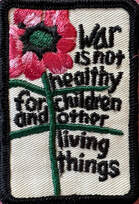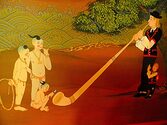
Once again the scourage of war threatens independence through deliberately misleading media manipulated by totalitarian egoists. Lies and missles fly.
These artworks reflect our experience.
More added throughout the summer.
 Once again the scourage of war threatens independence through deliberately misleading media manipulated by totalitarian egoists. Lies and missles fly. These artworks reflect our experience. More added throughout the summer.
0 Comments
MAXINE CABLE: TRANSFORMATION A RETROSPECTIVE SURVEY Featuring STUPA VILLAGE SEBROF FORBES CULTURAL ARTS CENTER 3535 University Boulevard West Kensington, MD, MD 20895 For more information contact Dennis Forbes email: [email protected] or (301) 933-4170 January 1- January 30, 2022 HOURS: Friday- Sunday 12-5 pm RECEPTIONS: Saturdays JANUARY 8th 1-4 PM with TOBI CISIN: HORN SOUNDS FROM THE ALPS & TIBET and JANUARY 29th 1-4 PM MASKS REQUIRED MAXINE CABLE (1931-2018) approached art as both a spiritual quest and a way of life. Cable’s installations transform functional, humble materials into a cumulative experience connecting the human spirit to greater cosmic forces. Maxine Cable’s stupa installation, made of baskets, exemplifies this transformation, evoking a sacred-relic atmosphere of Tibetan monuments that she knew from travel, study, and meditation on her journey to become a Buddhist. Many believe that circumambulating stupas both purifies negative karma and gives realizations on the path to enlightenment. In keeping with Buddhist thought, Cable disassembled her site-specific work after exhibitions and repurposed them anew. During this final stupa exhibition, the baskets are for sale to benefit SFCAC. The Sebrof Forbes Cultural Arts Center, a place for community gathering, is the perfect setting for this retrospective survey of Ms. Cable’s career. Her stupa installation is ringed with representative works of her artistic directions: painting, printmaking, veiled works, thangka-influenced hangings and assemblage sculptures addressing broad themes of family, nature, peace, enlightenment and war. Cable also used photographs taken by her artistic partner/husband, James Cable (1915-2012), documenting Buddhist monuments. The exhibition is curated by The Cabinet Art. Catalogs of Maxine Cable artworks and exhibitions cards will be available. ABOUT MAXINE CABLE: From the mid-1970s through the early 2000s, Maxine Cable was influential in the Washington DC art scene as an independent curator and as a founding member of Gallery 10, Ltd., at Dupont Circle from 1974 - 2010. Gallery 10 was established to exhibit the newest art genres, installations, and adventurous and experimental art, especially anything beyond the frame. Cable began her exhibition career with large geometric color field paintings and printmaking, exploring early Egyptian motifs before concentrating on assemblage and installation work reflecting her broad cultural interests in ritual and spirituality. An early installation at the Art Barn, questioning the conflicting ideals of womanhood in a chapel like setting, created a firestorm of attempted censorship resulting in a redemption of artistic freedom. During her decades as an exhibiting artist, Cable addressed broad social issues of war, peace, and ecology as well as spiritual development. Born in Philadelphia, Ms. Cable attended Tyler School of Fine Arts at Temple University before moving to the Washington, DC area to earn a BA at the Corcoran School of Art through George Washington University. After studying color theory with Hans Hoffman, she continued with graduate studies at American University where she met her husband, James T. Cable, (1915– 2012). They shared a deep interest in diverse cultural artistic expression and investigative art travel in the U.S., Europe, Egypt, and particularly Buddhist sites in Asia. She initiated many international exchange exhibitions at Gallery 10. The Cables participated in and supported many art groups including Artists Equity and The Vestal Virgins. Over the years the Cable home became their most eclectic and extensive installation reflecting not only life well-examined but also well-lived.  detail,Thai monastery nr Lucerne Switzerland detail,Thai monastery nr Lucerne Switzerland ABOUT TOBI CISIN: The Swiss alphorn, an ancient wood horn predating metallurgy, is used to play beautiful melodies primarily to call cows grazing in the mountains. The Tibetan dung-chen is a long metal horn that is used to play long, loud, low-pitched tones to summon good spirits and dispelling the bad ones. In Switzerland it is said that one time the buddha heard an alphorn in the Swiss alps and decided to have long horns in the mountains of Tibet. Alphorn Soloist Tobi Cisin performs on a beautiful handcrafted alphorn made in the Vaud Canton of Switzerland by the master alphorn maker, Gerald Pot and also specializes in French horn. She has a Master of Music degree from Indiana University and degrees in music education and anthropology. Ms Cisin studied with the great alphorn virtuoso, Jozef Molnar, Gilbert Kolly and William Hopson. During the summer, she spends time in the Swiss Alps and has attended many alphorn courses including Tzoumaz, Nendaz and the Alphorn Academy of Switzerland. In 2007 she competed in the top ten percent at the International Alphorn Competition of Nendaz. Her alphorn 1991 debut in Washington, DC with the Swiss Folklore Group was to celebrate the 700th anniversary of the founding of Switzerland. Since then Ms Cisin has appeared as a guest artist with the Folger Consort, many local orchestras, the International Horn Society Workshops and has performed at many Swiss, Austrian and German cultural events. She is affiliated with Blaskapelle Alte Kameraden, and the Swiss Folklore Group of Washington. In Switzerland it is said: “Once upon a time the buddha heard an alphorn in the swi Carolyn Prescott discusses |
Archives
June 2022
FIND
All
|